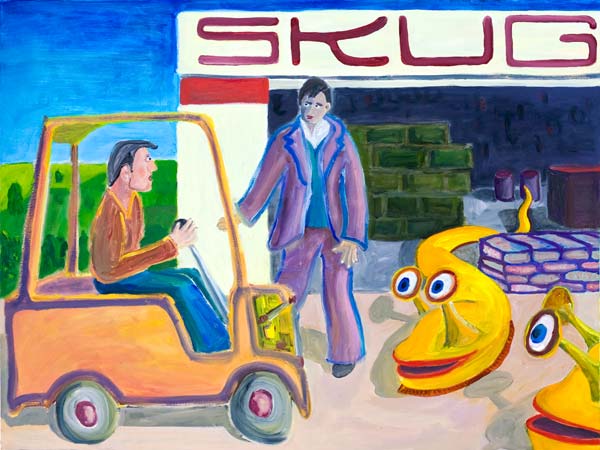I was happy for a few days last week about a new outline for my novel-in-progress, Turing & Burroughs , and I posted about the outline in, “Reading in SF. New Outline. Ripping Vinyl.” But now that I’m down to actually implementing it, it’s clear that the outline has a big hole in the middle. Not enough plot. So I’m re-doing it again, on the side, while I continue work on the new chapter.

[A great African mask in the African collection upstairs at the DeYoung museum.]
I think I will need something like what I was calling “dreamskugs” after all, that is, some incorporeal beings who one see from the corners of one’s eyes. But that isn’t the right name for them, for any talk about dreamskugs blends with and muddies the biocomputational skugs that Alan Turing discovered/invented/enabled. The spirit-things need their own name. So I’ll call them gazaks for now. An onomatopoeic word mimicking, say, Alan’s anxious grinding of his teeth and or retching at their initial appearance. “Gaaak!”

[“Turing and the Skugs”. More info on my paintings site. I can’t get enough of this painting! Pretty soon I might try and paint some gazaks too.]
I see the gazaks as elemental spirits, elves, discarnate ghosts, or perhaps minds as software images embodied in nature’s flows. Their interaction with us might as well be what potentiated the appearance of Turing’s skugs. The gazaks “saw” Turing on the verge of providing a biocomputational interface to link the two worlds, and they helped him make it happen. And then, near the end of the book, the gazaks soul-suck a lot of people off into their world, which may or may not be a pleasant place.

I’ve always felt that it’s okay to keep revising my plot outline as I go along. This dovetails with a lesson I’ve learned at a deep level over the years, to wit: “The World is Unpredictable.” I in fact have a very short essay with this title in this year’s edition of superagent and tummler John Brockman’s “World Question Center, 2011”, you can see me here about halfway down page two. Brockman got about a hundred and sixty people to answer the question, “What scientific concept would improve everybody’s cognitive toolkit?”

Unpredictability not only to the world at large, but to your personal life, as I describe in my 2004 blog post, “Free Will.” That is, even if the world is in some scientific sense deterministic, we cannot in practice to predict what we’ll be doing tomorrow. I wrote about this at some length in my tome on computation and the mind, The Lifebox, the Seashell, and the Soul,,

[Escaped tulpa from my novel “Jim and the Flims,” recently spotted in Los Gatos.]
But my point in today’s post is that unpredictability is being very much an aspect of how one dynamically works with the outline of a novel in progress. Quoting from my short how-to book, “A Writer’s Toolkit,” as revised in 2009.
When you’re writing a novel you’re working at the most extreme limit of your capabilities. What you’re doing is beyond logic, so far out at the limits of what you can do that there’s no hope of your having a short and manageable simulation of the process by which to figure out what you’re doing, it’s computationally irreducible. When you get into this zone, out on the very surface of your brain, you become sensitive to the tiniest chaotic emanations of the world outside. At times it feels as if the world, feeling your sensitivity, gladly dances back. Dosie-do. Keep your eyes peeled.

[Aardvark mask, also in the DeYoung.]
I’ve known this for quite a few years, but I’m always learning it at deeper levels. Here’s a quote from my “A Transrealist Manifesto” of 1983:
The Transrealist artist cannot predict the finished form of his or her work. The Transrealist novel grows organically, like life itself. The author can only choose characters and setting, introduce this or that particular fantastic element, and aim for certain key scenes. Ideally, a Transrealist novel is written in obscurity, and without an outline. If the author knows precisely how his or her book will develop, then the reader will divine this. A predictable book is of no interest. Nevertheless, the book must be coherent. Granted, life does not often make sense. But people will not read a book which has no plot. And a book with no readers is not a fully effective work of art. A successful novel of any sort should drag the reader through it. How is it possible to write such a book without an outline? The analogy is to the drawing of a maze. In drawing a maze, one has a start (characters and setting) and certain goals (key scenes). A good maze forces the tracer past all the goals in a coherent way. When you draw a maze, you start out with a certain path, but leave a lot a gaps where other paths can hook back in. In writing a coherent Transrealist novel, you include a number of unexplained happenings throughout the text. Things that you don’t know the reason for. Later you bend strands of the ramifying narrative back to hook into these nodes. If no node is available for a given strand-loop, you go back and write a node in (cf. erasing a piece of wall in the maze). Although reading is linear, writing is not.

[Cranes in the Amsterdam zoo.]
Finally, here’s some more about the unpredictability of plot from “Seek the Gnarl,” my Guest of Honor address at the International Conference for the Fantastic in the Arts in 2005. A variant of this talk appeared in the Journal of the Fantastic in the Arts, and I also have this excerpt in the how-to book that I mentioned above, “A Writer’s Toolkit.
With respect to plot structures, I see a spectrum of complexity. At the low end of complexity, we have standardized plots, at the high end, we have no plot at all, and in between we have the gnarly somewhat unpredictable plots. These can be found in two kinds of ways. I tend to use what I call the transreal approach of by fitting reality into a classic monomythic kind of plot structure and using some standard (say) science-fictional tropes. In the less flashy, but perhaps even more complex realistic mode, you try and mimic the actual world very precisely, working hard to avoid overlaying received ideas and cliches. In some ways, truth really is stranger than fiction. And so I view transreal fiction as a bit less computationally complex due to its position at the nexus of reality, fantasy, and the trellis of a classic plot structure such as the monomyth.
Complexity
Literary Style
Characteristics
Techniques
Predictable
Genre
A plot very obviously modeled to a traditional pattern.
Monomyth
Medium gnarl
Transrealism
Traditional story pattern enriched by realism. Observation acts on the fictional tropes to create unpredictable situations.
Realism + monomyth + power chords
High gnarl
Realism
A plot modeled directly on reality, with the odd and somewhat senseless twists that actually occur.
Observation, journals
Random
Surreal
Completely arbitrary events occur. (Tricky, as the subconscious isn’t all that random.)
Dreams, whims, external input.

Yum! The muse wants to help you.








